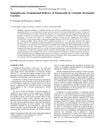Development and Optimization of Finasteride-Loaded Microemulsions for Transdermal Delivery
December 2019

TLDR Finasteride-loaded microemulsions, made with cinnamon oil, Tween20, propylene glycol, and water, can help maintain stemness of dermal cells, potentially aiding in hair regeneration.
Three years ago, a study was conducted on the effects of finasteride-loaded microemulsions for transdermal delivery on dermal papilla cells (DPCs) and human primary dermal papilla cells (HDPCs). The research found that finasteride increased stem cell related-transcription factors via the Wnt/β-catenin signaling pathway in these cells. When DPCs were treated with non-toxic concentrations of finasteride, there was a significant increase in aggregation behavior and stem cell transcription factors Sox-2 and Nanog. The microemulsions were developed using cinnamon oil, Tween20, propylene glycol, and water, with the optimal formulation being 11.85% oil phase, 58.42% surfactant mixture, and 30% water phase. The study concluded that finasteride maintained the stemness of DPCs, suggesting potential benefits for hair regeneration approaches.














